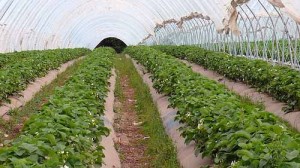
sharon mollerus/flickr
Strawberries are a great addition in your home garden. Not only is it fun for the whole family to pick juicy red fruits, these plants provide you with an ingredient that can spice up your dinner menu with scrumptious deserts.
Types of Strawberries
There are basically three types of strawberries to choose from when you decide to plant them in your garden. The type chosen depending on when you would like the plant to bear fruit as well as the quantity you desire. June strawberries are the most popular choice because they provide gardeners with the highest yield for each harvest. However, these produce only one crop each year in late spring. Ever-bearing varieties produce up to 2 to 3 crops annually, during spring, summer and fall, so you can actually get a year round supply of strawberries. However, the yield tends to be smaller than June bearing types. There are also the day-neutral strawberries. Like the ever-bearings, these produce yields throughout the season but yield much smaller crops.
Climate
The next step is to identify which planting zone you live in as this will factor into the timing of your planting. Strawberries are planted in fall or early winter in some areas, while in other areas they should not be planted until early spring when the ground can be worked on. Always remember though to plant only after the last frost has passed.
Strawberry plants survive well in moderate temperature that sees a lot of daylight. If you live in an area with occasional frost, steps must be taken to protect your plants. Place a tarp over the plants to prevent freezing should frost be forecasted.
If the area you live in has rainy seasons, make sure you check the site for any standing water as this will cause root rot and plant damage. If you spot accumulating water, dig a trench to allow the water to drain away from your strawberry patch.
Pests and Diseases
Pest and Fungal Attack
Strawberries are susceptible to fruit rots and leaf spots. Fruit rots are fungal diseases. These include gray mold (the most prevalent), tan rot, hard rot, leather rot, black seed rot and stem end rot. They occur more often than not when the conditions become moist, such as after heavy rains or high humidity. To prevent or at least reduce the incidence of fungal attack, use mulches like straw, hay or pine needles around the plants to keep ripening berries off the ground as this is where rotting often starts from. Thin the strawberry beds between seasons, as overcrowding encourages the spread of fruit rot. Pick the fruits as frequently during harvest season when the weather is warm and humid.
Tarnished plant bugs, strawberry weevils, spittlebugs and mites are the main culprits when it comes to pest attack on strawberries. Use the correct pesticide in the right amounts to stop these insect from attacking your plants.
Soil-Borne Diseases
Strawberries are also susceptible to soil-borne organisms such as black root, verticillium wilt and red stele. You need to ensure that the bed sites are free from soil borne disease and practice proper land management to prevent outbreaks. Also choose varieties of strawberries that are resistant to these diseases, and ensure that you site is well-drained.
Preparing Your Site
Strawberries can be grown anywhere from light sand to heavy clay type of soil. What you do need to take into account is an area where there is a lot of sunlight as strawberries require a good amount of sun exposure. They also do not tolerate large quantities of water, so you need to select a site that has adequate water drainage.
Till the ground about 12 inches deep and add compost. Strawberry plants like soil pH range of 5.5 to 7.0. The ideal pH though is 6.0 – 6.5. Test your soil and make any amendments required to provide a suitable soil for your strawberry patch. Add composted manure to the soil to increase available organic matter. Add also two pounds of 10-10-10 (four pounds 5-10-10, or equivalent) of fertilizer for every 100 square feet to increase the nitrogen level.

brian forbes/flickr
Planting the Strawberry
- Dig holes about 5 inches wide for each strawberry plant. Make sure that the hole is deep enough to cover the roots of the plant. If you use the “matted rows” method, plant the strawberries 18 to 30 inches apart with 3 to 4 feet spacing between the rows.
- Apply one to two pounds of 10-10-10 (or equivalent) per 100 square feet about four to six weeks after planting
- Repeat this fertilization before flowering period (depending on plant growth) to encourage bloom and fruiting.
- Once the plants start fruiting, do not apply fertilizer as too much nitrogen will result in too much vegetative growth and substandard fruits.
Note: The strawberry plants will send out “runners” after planting which are long stems that reach out from the mother plant. These will set down roots within the soil to establish new plants. Allow these runners fill the spaces between each strawberry plant within the rows but trim back runners that try to cross to another row.
Maintenance
- Lightly till the area between the rows and individual plants to keep the sole loose.
- To protect your plants from birds and squirrel attach, place a net over the strawberries.
- To protect the plants from frost, cover them with a plastic tarp at dusk then remove in the early morning the next day.
- As the temperature drops in fall, place mulch such as straw around the plants and under the fruit trusses to prevent the fruit from touching the ground. This also helps suppress weed growth and prevent fungal attach (see above Pest and Diseases). If you can get straw, use black plastic sheeting.
More Reading:
Growing Strawberries: What to Do Throughout The Seasons:
http://www.doityourself.com/stry/growing-strawberries–what-to-do-throughout-the-seasons
Strawberry Planting: When, Where, and How-To:
http://www.doityourself.com/stry/strawberry-planting-when-where-and-howto
Strawberries: http://gardening.about.com/od/fruitsberriesnuts/a/Strawberries.htm
Growing Strawberries: http://www.farminfo.org/garden/strawberries.htm

